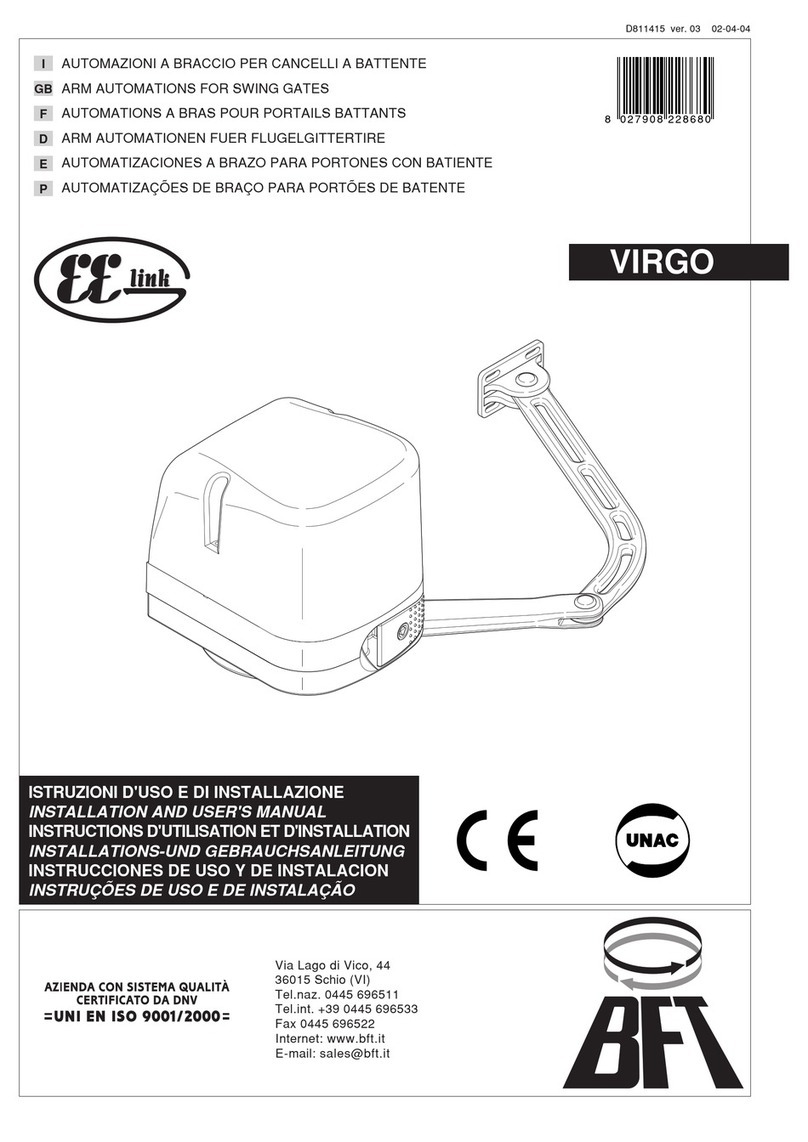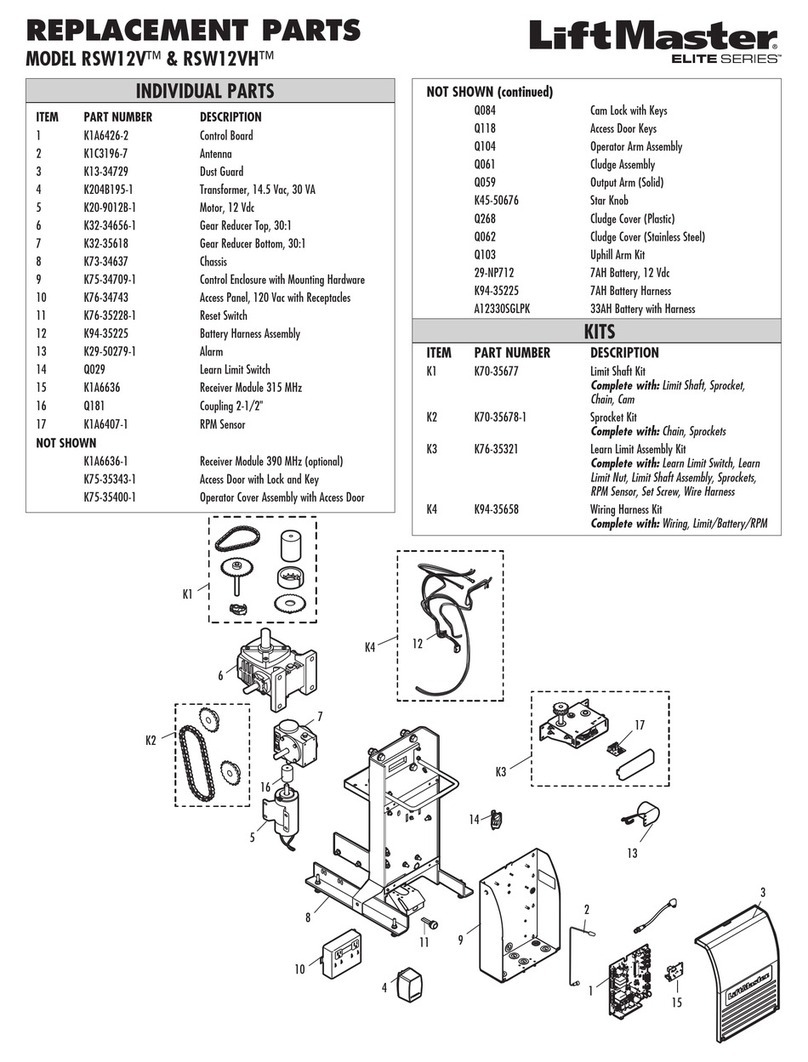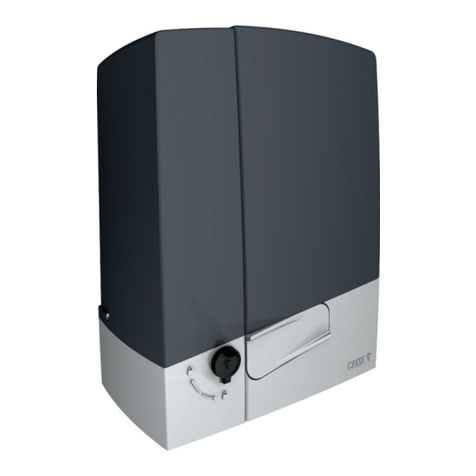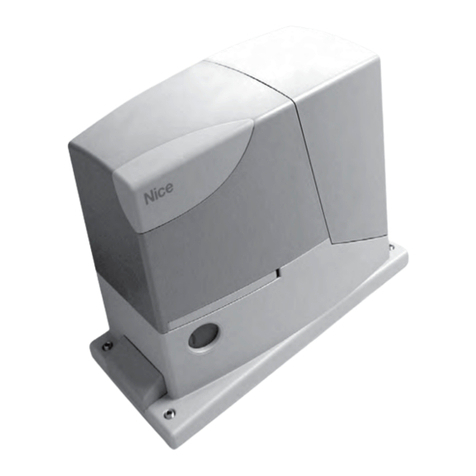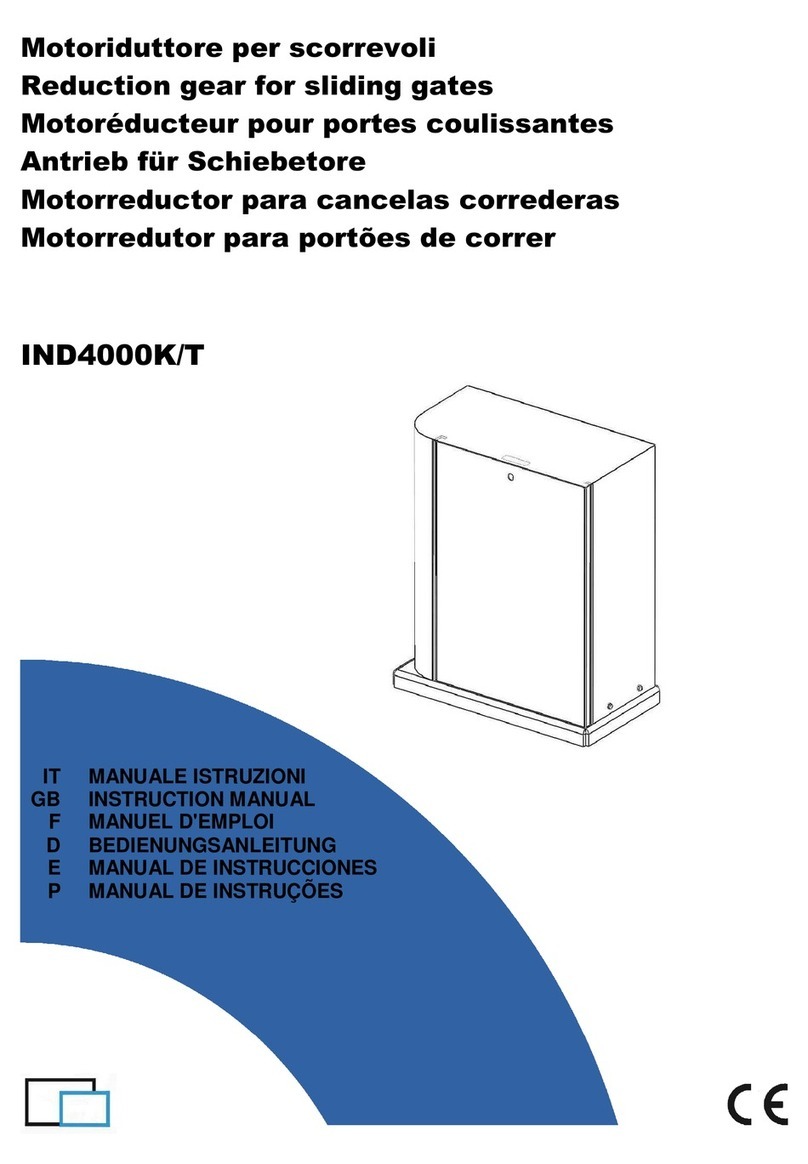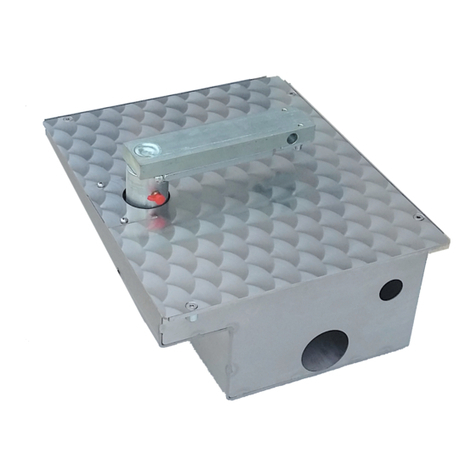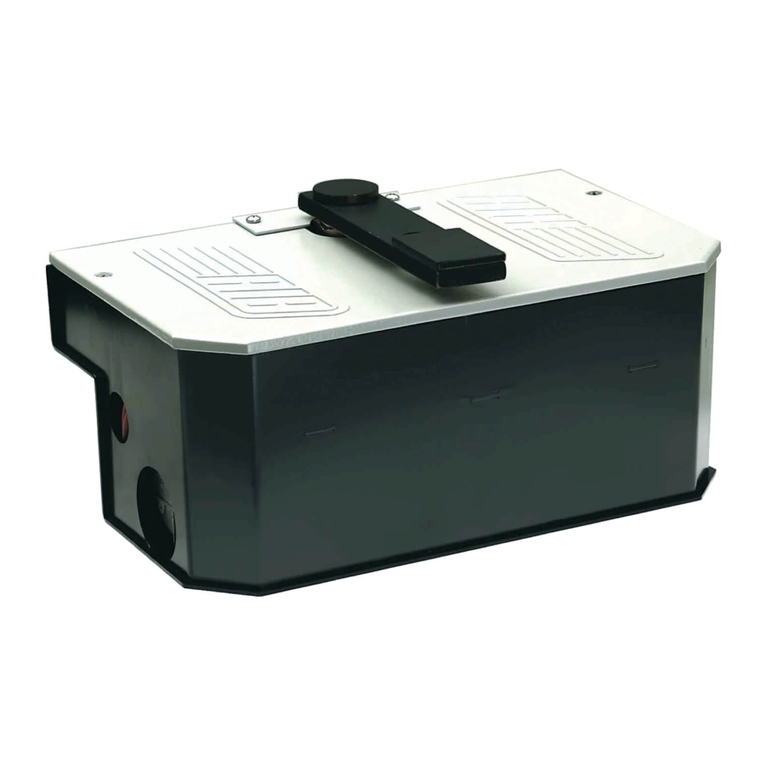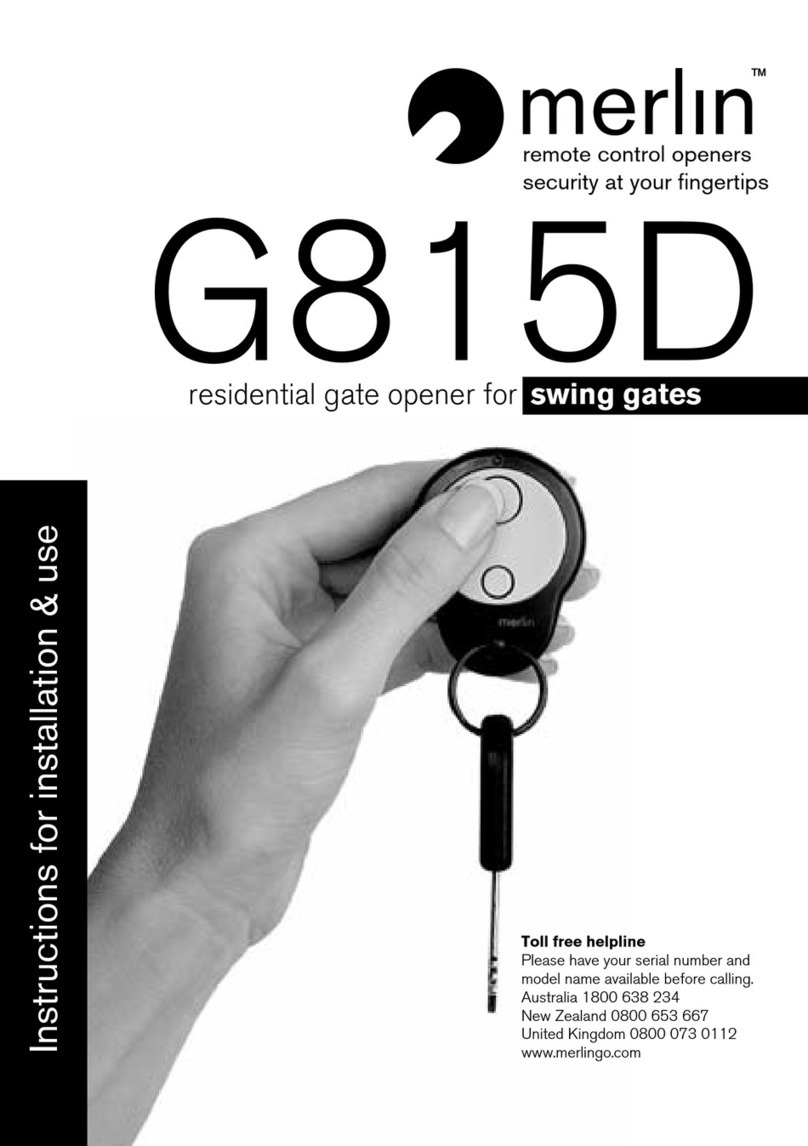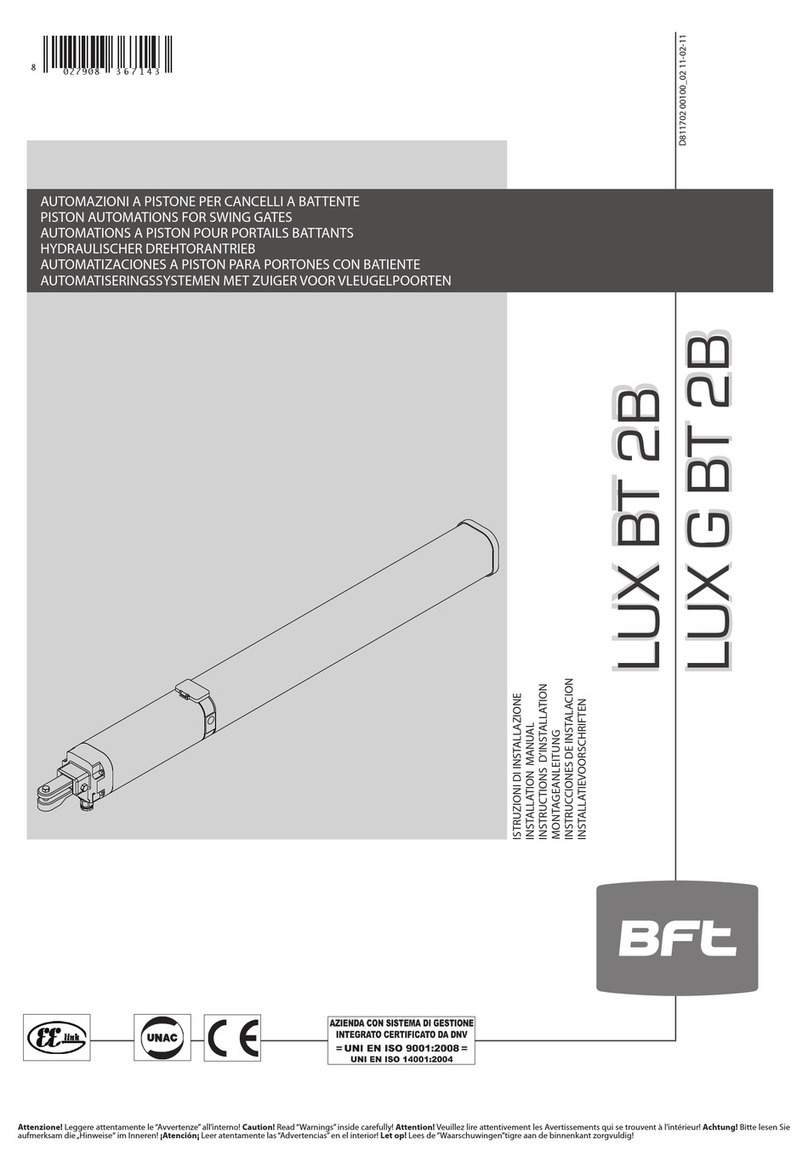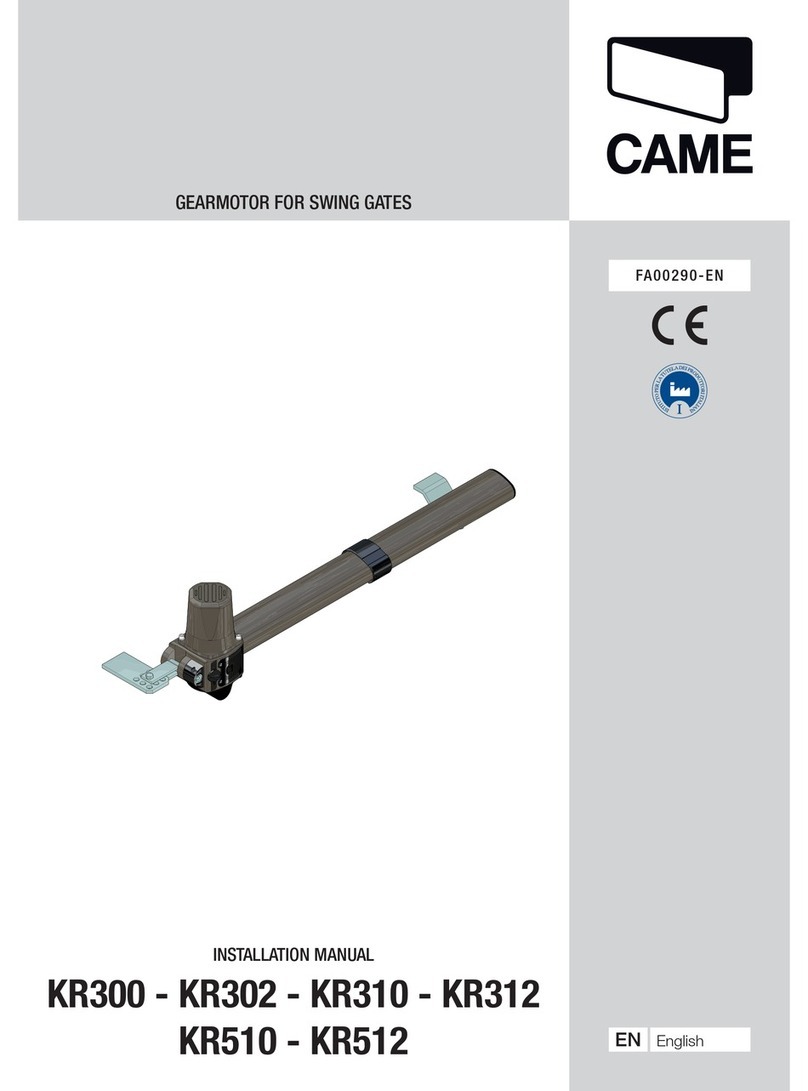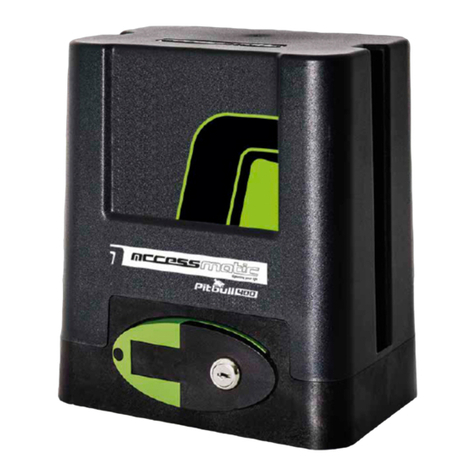Eelink Virgo User manual

ISTRUZIONI D’USO E DI INSTALLAZIONE
INSTALLATION AND USER’S MANUAL
INSTRUCTIONS D’UTILISATION ET D’INSTALLATION
INSTALLATIONS-UND GEBRAUCHSANLEITUNG
INSTRUCCIONES DE USO Y DE INSTALACION
INSTRUÇÕES DE USO E DE INSTALAÇÃO
VIRGO
AUTOMAZIONI A BRACCIO PER CANCELLI A BATTENTE
ARM AUTOMATIONS FOR SWING GATES
AUTOMATIONS A BRAS POUR PORTAILS BATTANTS
ARM AUTOMATIONEN FUER FLUGELGITTERTIRE
AUTOMATIZACIONES A BRAZO PARA PORTONES CON BATIENTE
AUTOMATIZAÇÕES DE BRAÇO PARA PORTÕES DE BATENTE
I
GB
F
D
E
P
D811415A ver.03 26-01-10
8027908 282781

2 - VIRGO
D811415A_03

USER’S MANUALENGLISH
Thank you for buying this product. Our company is sure that you will
be more than satised with the product’s performance. Carefully read
the “WARNINGS” pamphlet and the “INSTRUCTION BOOKLET” which
are supplied together with this product, since they provide important
information regarding the safety, installation, use and maintenance of
the product.This product complies with recognised technical standards
and safety regulations. We declare that this product is in conformity
with the following European Directives: 2006/95/ EEC, 2004/108/EEC,
2006/42/EEC and subsequent amendments.
1) GENERAL OUTLINE
Low-voltage operator (24V ) suitable for residential use. Designed for
swinggateshavingsmall-sizedpillars.The operating arm,withitsspecial
antishearing shape, allows the leaves to be manoeuvred even when the
operator is positioned well away from their fulcrum. The irreversible
electromechanical gearmotor keeps the gate locked in the closing and
opening positions.
Thereleaselever,ttedtotheoutsideofeachoperator,allowsthemanual
manoeuvre to be carried out very easily.
2) SAFETY
ATTENTION! The VIRGO model controller is not equipped with mecha-
nical torque adjustment. It is compulsory to use a control panel of the
same manufacturer, in compliance with the basic safety requirements
of directives 2006/95/CEE, 2004/108/CEE, 2006/42/CEE equipped with
appropriate electric adjusment of the torque.
WARNING. Important safety instructions. For the safety of persons,
itisimportanttofollowtheseinstructionsCarefullyreadtheinstruc-
tions for use and keep them for future reference.
When correctly installed and used, the operator meets the required
degree of safety. However, it is recommended to observe a few rules of
behaviour to avoid accidental problems.
- Keep children, adults and things outside the operator range, in parti-
cular during operation.
- Donotleaveradiotransmittersorotherdeviceswithinchildren’sreach,
in order to avoid unintentional operator movements.
- Do not intentionally contrast the leaf movement.
- Do not try to open the door manually, if the operator has not been
released with the appropriate release handle.
- Do not make changes to the operator components.
- In case of malfunction, disconnect the power supply, activate the
emergency release to allows access, and request the assistance of a
qualied technician (professional installer).
- Before any external cleaning or other maintenance operation, discon-
nect the power supply.
- If tted, keep the photocell optical elements and the luminous signal
devices clean. Check that there are no branches or shrubs obstructing
the safety devices (photocells).
- Foranyworktobecarriedoutdirectlyontheoperator,contactqualied
personnel (professional installer).
- Have the operator checked by qualied personnel once a year.
3) EMERGENCY MANOEUVRE (Fig. 1)
In the case where the power supply is o, or any faults are present, the
manual emergency manoeuvre can be carried out by operating the
external release lever (Fig.1 ref.”S”).
1) Insert the release key and turn it clockwise (Fig.1 ref.”1”).
2) Move lever “S” until the lock is released (Fig.1 ref.”2”).
3) Keep the lever in the release position by turning the key clockwise
(Fig.1 ref.”3”).
4) Push the leaf slowly to open or close the gate.
To reactivate motor-driven operation, turn the key clockwise to free the
lever from its released position, then return it to its initial position for
normal operation.
WARNING! Before carrying out the manual manoeuvre make sure that
this operation will not create dangerous situations.
4) DEMOLITION
WARNING! This operation should only be carried out by qualied
personnel.
Materials must be disposed of in conformity with the current regula-
tions.
In case of scrapping, the automation devices do not entail any particular
risksordanger.Incaseofmaterialsto berecycled,theseshouldbe sorted
out by type (electrical components, copper, aluminium, plastic etc.).
5) MAINTENANCE
WARNING! This operation should only be carried out by qualied
personnel.
When the automation system is disassembled to be reassembled on
another site, proceed as follows:
• Disconnectthepowersupplyandtheentireexternalelectricalin-
stallation.
• Inthecasewheresomeofthecomponentscannotberemovedor
are damaged, they must be replaced.
WARNINGS
Correct controller operation is only ensured when the data contai-
ned in the present manual are observed. The Company is not to
be held responsible for any damage resulting from failure to
observetheinstallation standardsandtheinstructionscontained
in the present manual.
The descriptions and illustrations contained in the present manual
are not binding.The Company reserves the right to make any alte-
rations deemed appropriate for the technical, manufacturing and
commercialimprovementoftheproduct,whileleavingtheessential
product features unchanged, at any time and without undertaking
to update the present publication.
Fig. 1
S
4 - VIRGO
D811415A_03

INSTALLATION MANUAL ENGLISH
Thank you for buying this product. Our company is sure that you will be
more than satised with the product’s performance.
Carefully read the “WARNINGS” pamphlet and the “INSTRUCTION
BOOKLET” which are supplied together with this product, since they
provide important information regarding the safety, installation, use
andmaintenanceof theproduct.Thisproduct complieswithrecognised
technical standards and safety regulations. We declare that this product
is in conformity with the following European Directives: 2006/95/ EEC,
2004/108/EEC, 2006/42/EEC and subsequent amendments.
1) GENERAL SAFETY
WARNING! An incorrect installation or improper use of the product can
cause damage to persons, animals or things.
• The“Warnings”leaet and“Instruction booklet”supplied with this
product should be read carefully as they provide important informa-
tion about safety, installation, use and maintenance.
• Scrappackingmaterials(plastic,cardboard,polystyreneetc)accor-
ding to the provisions set out by current standards. Keep nylon or
polystyrene bags out of children’s reach.
• Keeptheinstructionstogetherwiththetechnicalbrochureforfuture
reference.
• Thisproductwasexclusivelydesignedandmanufacturedforthe
use specied in the present documentation. Any other use not
specied in this documentation could damage the product and be
dangerous.
• TheCompanydeclinesallresponsibilityforanyconsequencesresul-
ting from improper use of the product, or use which is dierent from
that expected and specied in the present documentation.
• Donotinstalltheproductinexplosiveatmosphere.
• Theconstructioncomponentsofthisproductmustcomplywiththe
following European Directives: 2004/108/CEE, 2006/95/EEC, 2006/42/
EEC and subsequent amendments. As for all non-EEC countries, the
above-mentioned standards as well as the current national standards
should be respected in order to achieve a good safety level.
• TheCompanydeclinesallresponsibilityforanyconsequences
resulting from failure to observe Good Technical Practice when
constructing closing structures (door, gates etc.), as well as from any
deformation which might occur during use.
• Theinstallationmustcomplywiththeprovisionssetoutbythefol-
lowing European Directives: 2004/108/CEE, 2006/95/EEC, 2006/42/
EEC and subsequent amendments.
• Disconnecttheelectricalpowersupplybeforecarryingoutanyworkon
the installation. Also disconnect any buer batteries, if tted.
• Fitan omnipolarormagnetothermalswitchon themainspower
supply, having a contact opening distance equal to or greater than
3,5 mm.
• Checkthatadierentialswitchwitha0.03Athresholdisttedjust
before the power supply mains.
• Checkthatearthingiscarriedoutcorrectly:connectallmetalparts
for closure (doors, gates etc.) and all system components provided
with an earth terminal.
• Fitallthesafetydevices(photocells,electricedgesetc.)whichare
needed to protect the area from any danger caused by squashing,
conveying and shearing, according to and in compliance with the
applicable directives and technical standards.
• Positionatleastoneluminoussignalindicationdevice(blinker)where
it can be easily seen, and x a Warning sign to the structure.
• TheCompanydeclinesallresponsibilitywithrespecttotheautomation
safety and correct operation when other manufacturers’ components
are used.
• Onlyuseoriginalpartsforanymaintenanceorrepairoperation.
• Donotmodifytheautomationcomponents,unlessexplicitlyautho-
rised by the company.
• Instructtheproductuseraboutthecontrolsystemsprovidedand
the manual opening operation in case of emergency.
• Donotallowpersonsorchildrentoremainintheautomationope-
ration area.
• Keepradiocontrolorothercontroldevicesoutofchildren’sreach,
in order to avoid unintentional automation activation.
• Theusermustavoidanyattempttocarryoutworkorrepaironthe
automation system, and always request the assistance of qualied
personnel.
• Anythingwhichisnotexpresslyprovidedforinthepresentinstruc-
tions, is not allowed.
• Installationmustbecarriedoutusingthesafetydevicesandcontrols
prescribed by the EN 12978 Standard.
• Checkthatthestatedtemperaturerangeiscompatiblewiththeplace
where the operator is to be installed.
• Themotorcannotbeinstalledondoorswhichincorporatepedestrian
doors.
• Makesurethatsquashingisavoidedbetweenmovingparts and
nearby xed parts, checking that the following minimum safety
distances between the above-mentioned moving and xed parts
are respected: at least 25 mm to protect ngers, 50mm to protect
toes, 100mm for hands, 120 mm for arms and feet, 180 mm for legs,
300mm for the head and 500 mm for the body. Otherwise, t all the
safety devices (photocells, safety edges etc.) required to protect the
area from any danger of squashing, drawing in and shearing.
• Ifpresent,theholdbutton(hold-to-runcontrol)mustbettedwithin
sight of the door but away from moving parts, at a height of 1.5 m,
and must not be accessible to the public.
• Aftercarryingouttheinstallation,ensurethatmotorsettingiscorrect,
and that protection and release systems operate correctly.
2) GENERAL OUTLINE
Low-voltage operator (24V ) suitable for residential use. Designed for
swinggateshavingsmall-sizedpillars.The operating arm,withitsspecial
antishearing shape, allows the leaves to be manoeuvred even when the
operator is positioned well away from their fulcrum. The irreversible
electromechanical gearmotor keeps the gate locked in the closing and
opening positions.
Thereleaselever,ttedtotheoutsideofeachoperator,allowsthemanual
manoeuvre to be carried out very easily.
ATTENTION! The VIRGO model controller is not equipped with mecha-
nical torque adjustment. It is compulsory to use a control panel of the
same manufacturer, in compliance with the basic safety requirements
of directives 2006/95/CEE, 2004/108/CEE, 2006/42/CEE equipped with
appropriate electric adjusment of the torque.
Before carrying out the manual manoeuvre make sure that this operation
will not create a dangerous situations.
Check in the relevant literature that the thermal eld in the working area
is suitable for the operator.
Make sure that the movement of the door does not cause entrapment
risks between the movable and xed parts of the door.
If swing gates with built-in doors are used, the motor must not run when
the door is left open.
WARNING! The operator must be installed by a qualied technician as
special safety components are used for every specic site and therefore
safety depends on installation.
3) TECHNICAL SPECIFICATIONS
3.1) VIRGO OPERATOR
Motor: ..........................................................................................24V 2500 min-1
Power: ..................................................................................................................110W
Insulation class:..........................................................................................................F
Lubrication:................................................................................Permanent grease
Reduction ratio:.............................................................................................. 1-1224
Output shaft revolutions: .................................................................2 min-1 MAX
Opening time 90°:................................................................................................ 14s
Torque supplied: ..........................................................................................170 Nm
Max leaf weight and length:....................2000N (~200kg) for 2m long leaf
Impact reaction: .........................................................Integrated torque limiter
.................................................................................................on LINX control panel
Motion drive:............................................................................................. Lever arm
Stop:................ Incorporated electrical limit switches + mechanical locks
Manual manoeuvre: ...............................................Release lever with CLS key
Number of manoeuvres in 24h: ........................................................................ 60
Environmental conditions:...................................................from -15 to +50 °C
Degree of protection:........................................................................................ IPX4
Operator weight: ......................VIRGO:80N (~8kg) - VIRGO SQ:60N (~6kg)
Dimensions:...................................................................................................see g.1
3.2) LINX CONTROL PANEL
Power supply: ....................................................................... 230V~ ±10% 50Hz*
Mains/low voltage insulation: ............................................> 2MOhm 500Vdc
Working temperature ............................................................from -15 to +50 °C
Dielectric strength: ....................................... mains/l.v. 3750V~ for 1 minute
Motor output current: .................................................................3.5A+3.5A max
VIRGO - 17
D811415A_03

Motor relay commutation current: .............................................................. 10A
Maximum motor power:...............................................................110W (24V )
Power supply for accessories: ...................24V~ (180mA max absorption)
......................................................................24V~ safe (180mA max absorption)
Gate-open warning light: .................................N.O. contact (24V~/1A max)
Blinker: .............................................................................................. 24V~ 25W max
Dimensions: ...........................................................................................see gure 1
Fuses: ........................................................................................................ see g.9-15
(*other voltages available on request)
3.3) VIRGO BAT BATTERY KIT (OPTIONAL - Fig.14)
Allows operation to continue even when the mains power supply is o
for a short time.
Charge voltage: .............................................................27.2V Charge cur-
rent: ...................................................................................................................130mA
Data detected with external temperature of: .........................................25°C
Battery capacity: .............................................................................2x (12V 1.2Ah)
Exhausted battery protection threshold: ..........................................20.4V
Battery recharge time: ...............................................................................12/14 h
NOTE: In case of operation with battery back up, the outputs to termi-
nals 8-9 (Vsafe 24V~) and 10-11 (Vsafe 24V~) show a voltage of 24V
polarised as indicated in Fig.16.
At the time of installing theVIRGO BAT Kit, check that the safety devices
are connected correctly.
4) OPERATOR INSTALLATION
4.1) Preliminary checks
Check that:
• Thegatestructureissucientlysturdyandrigid.
The xing position must be worked out according to the leaf structu-
re. In any case, the manoeuvring arm must push against a reinforced
leaf point.
• Theleavescanbemovedmanuallyalongtheirentirestroke.
If the gate has not been installed recently, check the wear condition of
all its components. Repair or replace defective and worn parts.
Operator reliability and safety are directly aected by the condition
of the gate structure.
5) SUPPORT PLATE FIXING (Fig.5)
The operator is supplied with a xing bracket and lever arm.
Having identied the leaf reinforcement point, with the gate closed,
trace an imaginary horizontal line from the centre of the reinforcement
point to the pillar (g. 3-4).
Fig. 2 illustrates the most common types of installation:
- with the leaf hinge pivot not aligned with the xing plate (90° opening
- maximum distance between hinge pivot and plate: 210mm).
- with the hinge pivot aligned with the xing plate
Position the anchoring bracket observing the dimensions shown in
g.3 for opening up to 90°, or in g.2-4 for opening over 90° up to a
max of 120°.
The pillar surface, where the bracket is xed, must be at and parallel
to the leaf. Use screws and expansion plugs adequate for the type of
pillar. In the case where the pillar surface is irregular, use expansion
plugs with studs, in order to be able to adjust the xing bracket parallel
to the leaf (g.5).
• Assembletheleverarmasing.7.
DX = tting to right leaf
SX = tting to left leaf
Choose the most suitable position for xing bracket“F”to the leaf.
• InsertleverLintothegearmotoroutputshaft,andxitusingappro-
priate pivot P and self-locking nut D (g.7).
• Releasetheoperatorbyactivatingthereleaselevertoallowthearm
to move easily (see paragraph “EMERGENCY MANOEUVRE”).
• OpenthegearmotorcoverandxittotheplateasindicatedinFig.8.
• Fixtowinganglebar“F”totheleaf.
• Thecorrectpositionfortheoperatorarmisillustrateding.6.Theleaf
attachment point can be identied by positioning the arm according
to the dimension indicated in g.6.
• Withtheoperatorreleased,checkthearmforcorrectmovement.
• Repeatthesameprocedurefortheotherleaf.
6) BACKSTOP FIXING
TheVIRGOoperatorisprovidedwithmechanical end-of-strokebackstops,
which make the installation of ground stop plates redundant.
With reference to Fig. 10 proceed as follows:
- Identify the opening and closing end-of-stroke points and x the
backstops accordingly.
- Fix protection cover C.
7) ELECTRICAL INSTALLATION SET-UP
Arrange the electrical installation as shown in g.11.
Keep the mains voltage connections denitely separate from the very
low voltage connections (24V).
For thispurpose,theoperatorisprovidedwith appropriatettings,indicated
in Fig.9, for a spiral exible raceway with an inside diameter of 20:
- P1 input for mains power supply + GND.
- P2/P3 inputs for safety devices and accessories.
For the mains power supply, use the appropriate cable clamp (Fig.9 -”S”),
the terminal bar with an incorporated protection fuse (Fig.9 -”L-N”) and
the GND terminal.
Connect the yellow/green cable to the earth terminal.
Fig.16 shows the cross-section and the number of connections.
8) TERMINAL BAR CONNECTIONS (Fig.16)
NOTE:TheVIRGOoperatorsprovidedwithincorporatedLINXcontrol
panels are preset for tting to the left leaf, whereas the operators
without panels (VIRGO-SQ) are preset for tting to the right leaf, as
illustrated by the example given in Fig.11.
Should it be necessary to reverse the operator opening direction, pro-
ceed as follows:
1 – Reverse motor polarity (JP1 terminals 1-2)
2 – Reverse motor polarity (JP2 terminals 14-15)
WARNING – During the wiring and installation operations, refer to the
current standards as well as principles of good technical practice.
The (24V) very low voltage conductors must be physically separated
from the low voltage conductors or otherwise be adequately isolated
by means of an additional insulation of at least 1 mm.
The wires must be clamped by an extra fastener near the terminals, for
example by bands.
All the connection cables must be kept at an adequate distance from
the dissipator(Fig.15“D”).
WARNING! For connection to the mains, use a multipolar cable with
a minimum of 3x1.5mm2cross section and complying with the pre-
viously mentioned regulations. For example, if the cable is out side
(in the open), it has to be at least equal to H07RN-F, but if it is on the
inside (or outside but placed in a plastic cable cannel) it has to be
or at least egual to H05VV-F with section 3x1.5mm2.
JP1
1-2 Motor 2 connection (VIRGO with LINX panel):
3-5 Opening limit switch SWO M2 (N.C.)
4-5 Closing limit switch SWC M2 (N.C.)
6-7 24 V~ power supply input from the transformer
JP2
8-9 24V~Vsafe180mAmax output–powersupplyforphotocell
transmitters with check (Fig.17)
10-11 24V~ 180mA max output – power supply for photocells or
other devices
12-13 Blinker connection (24V~ 25W max)
14-15 Motor 1 connection (VIRGO-SQ – without LINX panel -):
16-18 Opening limit switch SWO M1 (N.C.)
17-18 Closing limit switch SWC M1 (N.C.)
19-24 Pedestrian opening button PED (N.O.). Controls partial
opening of Motor M2.
20-24 Fault input (N.O.). Input for photocells or safety devices
provided with an N.O. check contact.
21-24 Photocell input (N.C.). If not used, leave bridged (Fig.17).
22-24 STOP button (N.C.). If not used, leave bridged.
23-24 START button (N.O.).
25-26 Output for gate-open warning light (N.O. contact (24V~/1A
max) or alternatively for 2nd radio channel (see congura-
tion -“logics” menu)
27-28 Antenna input for incorporated radio-receiver board (27
braid - 28 signal).
INSTALLATION MANUAL
ENGLISH
18 - VIRGO
D811415A_03

INSTALLATION MANUAL ENGLISH
9) PROGRAMMING
The control panel provided with a microprocessor is supplied with
function parameters preset by the manufacturer, suitable for standard
installations. The predened parameters can be altered by means of
either the incorporated display programmer or Universal palmtop
programmer.
In the case where programming is carried out by means of Universal
palmtopprogrammer,carefullyreadtheinstructionsrelatingtoUniversal
palmtop programmer, and proceed in the following way.
Connect the Universal palmtop programmer to the control unit through
the UNIFLAT and UNIDA accessories (See g. 18). The LINX control unit
does not supply the Universal palmtop programmer with power, and
therefore requires an appropriate supply unit.
Enter the “CONTROL UNITS” menu, and the “PARAMETERS” submenu,
then scroll the display screenfuls using the up/down arrows to set the
numerical values of the parameters listed below.
For the function logics, refer to the“LOGIC”submenu.
In the case where programming is carried out by means of the incor-
porated programmer, refer to Fig. A and B and to the paragraph on
“Conguration”.
10) CONFIGURATION
The display programmer is used to set all the LINX control panel fun-
ctions.
The programmer is provided with three pushbuttons for menu scrolling
and function parameter conguration:
+ menu scrolling/value increment key
- menu scrolling/value reduction key
OKEnter (conrm) key
The simultaneous pressure of the + and - keys is used to exit the active
menu and move to the preceding menu.
The modications made are only set if the OK key is subsequently
pressed.
When the OK key is pressed for the rst time, the programming mode
is entered.
The following pieces of information appear on the display at rst:
- Control unit software version
- Number of total manoeuvres carried out (the value is expressed in
thousands, therefore the display constantly shows 0000 during the
rst thousand manoeuvres).
- Numberofmanoeuvrescarriedoutsincethelatestmaintenanceopera-
tion(the valueis expressedin thousands,thereforethe displayconstantly
shows 0000 during the rst thousand manoeuvres).
- Number of memorised radio control devices.
When the OK key is pressed during the initial presentation phase, the
rst menu can be accessed directly.
Herefollowsalistofthemainmenusandtherespectivesubmenusavaila-
ble.The predened parameter is shown between square brackets [ 0 ].
The writing appearing on the display is indicated between round
brackets.
Refer to Figures A and B for the conguration procedure.
10.1) PARAMETER MENU (PARAm)
- Automatic Closing Time (TCA) [ 10s ]
Set the numerical value of the automatic closing time from 3 to 90
seconds.
- Motor 1 torque (m1 t) [ 50% ]
Set the numerical value of the motor 1 torque between 1% and
99%.
- Motor 2 torque (m2 t) [ 50% ]
Set the numerical value of the motor 2 torque between 1% and
99%.
- Motor 1 slow-down torque (m1 t slow) [ 45% ]
Set the numerical value for slow-down torque of motor 1 between
1% and 99%.
- Motor 2 slow-down torque (m2 t slow) [ 45% ]
Set the numerical value for slow-down torque of motor 2 between
1% and 99%.
NOTES: In case of obstacle detection, the Ampere-stop function
stops the leaf movement, reverses the motion for 1 sec. and then
halts in the STOP status.The motor slow-down torque represents the
maximumtorquesuppliedtothemotorduringtheslow-downphase.
It must be set to a lower value with respect to the motor torque, in
order to allow the Ampere-stop function to be also activated during
the slow-down phase.
WARNING: Check that the impact force value measured at
the points established by the EN 12445 standard is lower than
that specied in the EN 12453 standard.
Incorrect sensitivity setting can cause injuries to persons or
animals, or damage to things.
- Opening delay time (open delay time) [ 1s ]
Set the opening delay time for motor 2 relative to motor 1, between
1 and 10 seconds.
- Closing delay time (cls delay time) [ 1s ]
Set the closing delay time for motor 1 relative to motor 2, between
1 and 30 seconds.
- Motor 1 Normal Speed Time (m1 fast time) [ 15s ]
Set the time to normal speed (not slowed down), ranging from 1 to
30 seconds.
- Motor 2 Normal Speed Time (m2 fast time) [ 15s ]
Set the time to normal speed (not slowed down), ranging from 1 to
30 seconds.
Note: The slow-down time, on closing and on opening, is obtained
by timing one manoeuvre, and setting a lower value within this pa-
rameter. If, forexample,one manoeuvrelasts25 seconds,set“normal
speed time”to 20s to obtain 5s of slow-down time, both on closing
and on opening.
- Slow-down speed (slov speed) [ 0 ]
Set the slow-down speed by choosing from the following values:
0 – slow-down disabled
1 – slow-down to 50% of normal speed
2 – slow-down to 33% of normal speed.
3 – slow-down to 25% of normal speed.
10.2) LOGIC MENU (logic.)
- TCA (TCA) [ OFF ]
ON Activates automatic closing
OFF Excludes automatic closing
- 3 Steps (3 step) [ OFF ]
ON Enables 3-step logic. A Start impulse has the following eects:
door closed:..........................................................................................opens
on opening:................................stops and enters TCA (if congured)
door open:..............................................................................................closes
on closing:.....................................................................stops and reopens
OFF Enables 4-step logic. A Start impulse has the following eects:
door closed:...........................................................................................opens
on opening:................................stops and enters TCA (if congured)
door open:..............................................................................................closes
on closing:...................................stops and does not enter TCA (stop)
after stopping: .....................................................................................opens
- Impulse lock (ibl open) [ OFF ]
ON The Start impulse has no eect during the opening phase.
OFF The Start impulse becomes eective during the opening or
closing phase.
- Rapid closing (fast cls) [ OFF ]
ON Closes thegateafterphotocelldisengagement, beforewaitingfor
the end of the TCA set.
OFF Command not entered.
- Photocells on opening photc. open [ OFF ]
ON
In case of obscuring, this excludes photocell operation on opening.
During the closing phase, it immediately reverses the motion.
OFF In case of obscuring, the photocells are active both on opening
and on closing.When a photocell is obscured on closing, it reverses
the motion only after the photocell is disengaged.
- Photocell test (test phot) [ OFF ]
ON Activates photocell check
OFF Deactivates photocell check
If this setting is not activated (OFF), it inhibits the photocell che-
cking function, allowing connection of devices not provided with
additional checking contact.
- Gate-open or 2nd radio channel warning light (SCA 2ch) [ OFF ]
ON The output between terminals 25 and 26 is congured as Gate-
open warning light, in this case the 2nd radio channel controls
pedestrian opening.
OFF The output between terminals 25 and 26 is congured as 2nd
radio channel.
- Motors in operation (1 mot ON) [ OFF ]
ON Only motor 2 is in operation (terminals 1 and 2).
With this conguration, the pedestrian input is disabled.
OFF Both motors are in operation.
VIRGO - 19
D811415A_03

INSTALLATION MANUAL
ENGLISH
- Lock hold (bloc persist) [ OFF ]
ON To be used when opening and closing mechanical backstops
are tted.
This function activates leaf pressure on the backstop, without this
being considered as an obstacle by the ampere-stop sensor.
Then the leaf continues its stroke for another 0,5s, after intercep-
ting
the limit switches.Therefore the limit switches are triggered
slightly
in advance, and the leaves will stop perfectly on the end
stop plate.
OFF To be used when no mechanical backstops are tted.
Movement is exclusively stopped by the limit switches being trig-
gered; in this case it is necessary to set the opening and closing
limit switch triggering point with precision.
- Prealarm (preal) [ OFF ]
ON The blinker comes on about 3s before the motors start.
OFF The blinker comes on at the same time as the motors start
- Fixed code (fixed code) [ OFF ]
ON The receiver is congured for operation in xed-code mode, see
paragraph on“Radio Transmitter Cloning”.
OFF The receiver is congured for operation in rolling-code mode, see
paragraph on“Radio Transmitter Cloning”.
- Radio transmitter programming (radio prog) [ ON ]
ON This enables transmitter storage via radio:
1 – First press the hidden key (P1) and then the normal key (T1, T2,
T3 or T4) of a transmitter already memorised in standard mode
by means of the radio menu.
2 – Within 10s press the hidden key (P1) and the normal key (T1,
T2, T3 or T4) of a transmitter to be memorised.
The receiver exits the programming mode after 10s, other new
transmitters can be entered before the end of this time.
This mode does not require access to the control panel.
OFF This disables transmitter storage via radio.
The transmitters can only be memorised using the appropriate
Radio menu.
- Motor logic reversal (change mot.) [ OFF ]
ON Mot.1: it is the rst to start on opening and the last to start on clo-
sing.
Mot.2: it is the last to start on opening and the rst to start on clo-
sing.
OFF Mot.1: it is the last to start on opening and the rst to start on clo-
sing.
Mot.2: it is the rst to start on opening and the last to start on closing.
10.3) RADIO MENU (RADIO)
- Add
Allows you to add one key of a radio control device to the receiver
memory; after storage it displays a message showing the receiver
number in the memory location (from 01 to 64).
Add Start button (add start)
associates the required key to Start command
Add 2ch button (add 2ch)
associates the required key to 2nd radio channel
- Read (read)
Checks one key of a receiver; if stored it displays a message showing
the receiver number in the memory location (from 01 to 64), and the
key number (T1, T2, T3 or T4).
- Eliminate list (erease 64)
WARNING! Completely removes all memorised radio control devices
from the receiver memory.
- Receiver code reading (RX code)
This displays the code entered in the receiver.
Consult paragraphs 12-13-14-15 for further information concerning
the advanced functions of the Clonix incorporated receiver.
10.4) LANGUAGE MENU (language)
Allows you to set the language on the display programmer.
- ITALIAN (ITA)
- FRENCH (FRA)
- GERMAN (DEU)
- ENGLISH (ENG)
- SPANISH (ESP)
10.5) DEFAULT MENU (default)
Restores the preset default values on the control unit. After restoring, a
new autoset operation must be carried out.
10.6) DIAGNOSTICS AND MONITORING
The display on the LINX panel shows some useful information, both
during normal operation and in the case of malfunctions.
Diagnostics:
In the case of malfunctions, the display shows a message indicating
which device needs to be checked:
PED = PED input activation
STRT = START input activation
STOP = STOP input activation
PHOT = PHOT input activation
FLT = FAULT input activation for checked photocells
SWO1 = activation of Motor 1 opening limit switch input
SWC1 = activation of Motor 1 closing limit switch input
SWO2 = activation of Motor 2 opening limit switch input
SWC2 = activation of Motor 2 closing limit switch input
In the case where an obstacle is found, the LINX panel stops the door
and activates a reverse manoeuvre; at the same time the display shows
the“AMP”message.
Monitoring:
During the opening and closing phases, the display shows four digits
separated by a dot, for example 35.40. The digits are constantly updated
during the manoeuvre, and represent the maximum torque reached by
motor 1 (35) and motor 2 (40).
These values allow the torque setting to be corrected.
Ifthemaximumtorquevaluereachedduringthemanoeuvregetssensibly
close to the value set in the parameter menu, malfunctions may occur
in the future following wear or slight door deformation.
It is therefore advisable to check the maximum torque reached during
some of the manoeuvres carried out in the course of installation, and
if necessary set a value about 15-20 percent points higher in the para-
meter menu.
10.7) AUTOSET MENU (autoset)
Allows you to automatically set the Motor torque.
WARNING!!Theautosetoperationisonlytobecarriedoutafterchecking
the exact leaf (opening/closing) movement, and correct limit-switch
activation.
As soon as the OK pushbutton is pressed, the “.... ....” message is displa-
yed, and the control unit executes an opening manoeuvre followed by
a closing manoeuvre, during which the minimum torque value needed
for leaf movement is automatically set.
During this phase, it is important to avoid obscuring the photocells, as
well as using the START, STOP or PED commands and the display.
After this, if autosetting has been successfully completed, the control
unit displays the “OK” message and, after pressing any key, returns to
the Autoset menu.
If,onthe otherhand,the controlunitdisplaysthe“KO”message,itmeans
thattheautosetprocedurehasnotbeensuccessfullycompleted;itisthus
necessary tocheck thewear conditionof thegate andthe regularmove-
ment of the leaves before proceeding to a new autoset operation.
WARNING! During the autoset phase, the obstacle detection function is
notactive,thereforetheinstallermustcontroltheautomationmovement
and prevent persons and things from approaching or standing within
the automation working range.
In the case where buer batteries are used, autosetting must be carried
out with the control panel supplied by mains power voltage.
WARNING: Check that the impact force value measured at the
points established by the EN 12445 standard is lower than that
specied in the EN 12453 standard.
Incorrect sensitivity setting can cause injuries to persons or
animals, or damage to things.
11) STATISTICS
Having connected the Universal palmtop programmer to the control
unit,enterthe CONTROL UNIT/STATISTICSmenuandscrollthescreenful
showing the statistical parameters:
- Board microprocessor software version.
- Number of cycles carried out. If motors are replaced, count the
number of manoeuvres carried out up to that time.
- Number of cycles carried out from the latest maintenance opera-
tion.
It is automatically set to zero after each self-diagnosis or parameter
writing.
20 - VIRGO
D811415A_03

INSTALLATION MANUAL ENGLISH
- Date of latest maintenance operation.To be updated manually from
the appropriate menu“Update maintenance date”.
- Installation description. 16 characters can be entered for installation
identication.
12) INTEGRATED RECEIVER TECHNICAL SPECIFICATION
Receiver output channels:
- output channel 1, if activated, controls a START command.
- output channel 2, if activated, controls the excitation of the 2nd radio
channel relay for 1s.
Transmitter versions which can be used:
all Rolling Code transmitters compatible with .
ANTENNA INSTALLATION
Use an antenna tuned to 433MHz.
For Antenna-Receiver connection, use RG8 coaxial cable.
The presence of metallic masses next to the antenna can interfere with
radioreception.Incaseofinsucienttransmitterrange,movethean-
tenna to a more suitable position.
13) RECEIVER CONFIGURATION
Theon-boardreceivercombinescharacteristicsofutmostsafetyincopy-
ing variable code (rolling code) coding with the convenience of carrying
out transmitter“cloning”operations thanks to an exclusive system.
Cloning a transmitter means creating a transmitter which can be au-
tomatically included within the list of the transmitters memorised in
the receiver, either as an addition or as a replacement of a particular
transmitter.
Cloning by replacement is used to create a new transmitter which takes
the place of the one previously memorised in the receiver; in this way
a specic transmitter can be removed from the memory and will no
longer be usable.
Thereforeit willbepossibletoremotelyprogramalargenumberofadditional
transmitters or, for example, replacement transmitters for those which have
been lost, without making changes directly to the receiver.
When coding safety is not a decisive factor, the on-board receiver allows
you to carry out xed-code additional cloning which, although abando-
ningthe variable code, providesahigh number ofcodingcombinations,
therefore keeping it possible to“copy”any transmitter which has already
been programmed.
PROGRAMMING
Transmitterstoragecanbecarriedoutinmanualmodeorbymeansofthe
Universal palmtop programmer which allows the complete installation
database to be managed through the Eedbase software.
In this second case, receiver programming takes place through the con-
nection of Universal palmtop programmer to the LINX control panel,
using the UNIFLAT and UNIDA accessories as indicated in Fig. 18.
14) MANUAL PROGRAMMING
In the case of standard installations where advanced functions are not
required, youcanproceedtomanualstorageof thetransmitters,making
reference to g. B for basic programming.
- If you wish the transmitter to activate output 1 (START) by means of
key1, key2, key3 or key4, enter the transmitter in menu“Start key”, as
in g. B.
- If you wish the transmitter to activate output 2 (2nd radio channel
relay) by means of key1, key2, key3 or key4, enter the transmitter in
menu“2nd ch. key”, as in g. B.
Note:HiddenkeyP1appearsdierentlydependingonthetransmitter
model.
For transmitters with hidden key, press hidden key P1 (g. B1). For
transmitters without hidden key, the key P1 function corresponds
to simultaneously pressing the 4 transmitter keys or, after opening
the battery compartment, bridging the two P1 points by means of
a screwdriver (g. B2).
IMPORTANT NOTE:ATTACHTHEADH ESIVEKEYLABELTOTHE FIRST
MEMORISED TRANSMITTER (MASTER).
In the case of manual programming, the rst transmitter assigns the
key code to the receiver; this code is necessary in order to carry out
subsequent cloning of the radio transmitters.
15) RADIO-TRANSMITTER CLONING
Rolling-code cloning / Fixed-code cloning
Make reference to the Universal palmtop programmer Instructions and
the CLONIX Programming Guide.
15.1) ADVANCED PROGRAMMING: COLLECTIVE RECEIVERS
Make reference to the Universal palmtop programmer Instructions and
the CLONIX Programming Guide.
16) LIMIT SWITCH ADJUSTMENT (Fig.12)
• Identifytheopeningandclosinglimitswitches(FC1andFC2)taking
into account that:
FC1 corresponds the CLOSING limit switch
FC2 corresponds the OPENING limit switch.
• Withthegatecompletelyclosedoropened,rotatethecorresponding
cam until the relevant limit microswitch is heard being tripped, then
lock the cam into position by means of the appropriate screws.
• Checkthatthelimitswitchesaretriggeredcorrectly,byinitiatinga
few complete motor-driven opening and closing cycles.
• Ifthe“lockhold”logicissettoONintheLINXpanel,theleafcontinues
itsstrokeforabout0,5seconds,inordertoensurestabilityandperfect
leaf stopping against the end-of-stroke backstops.
17) EMERGENCY MANOEUVRE (Fig.19)
In the case where the power supply is o, or any faults are present, the
manual emergency manoeuvre can be carried out by operating the
external release lever (Fig.1 ref.”S”).
1) Insert the release key and turn it clockwise (Fig.19 ref.”1”).
2) Move lever“S” until the lock is released (Fig.19 ref.”2”).
3) Keep the lever in the release position by turning the key clockwise
(Fig.19 ref.”3”).
4) Push the leaf slowly to open or close the gate.
To reactivate motor-driven operation, turn the key clockwise to free the
lever from its released position, then return it to its initial position for
normal operation.
18) MANUAL WIRE RELEASE DEVICE (Fig.13)
The manual emergency release can be operated by a wire device:
- Take all the metal cable out of the sheath and insert it into the release
lever.
- Lock the sheath and suitably adjust its position by means of the
appropriate screw.
- The cover is provided with a section to be torn o for the sheath to
go through.
- Forfurtherinformation,refertothespecicinstructionsfortherelease
device.
19) VIRGO BAT KIT INSTALLATION
- Fix the SBS board on the back of the panel box by means of a screw,
as indicated in Fig.14.
- Fix the board protection box (Fig.14 - “C”) supplied with the kit.
-
Position the two batteries on the supports, as indicated in Fig.14 (“A”).
- Secure the batteries using the bracket and screws supplied.
- Proceed to wire the SBS board with reference to the diagram in
Fig.14.
20) AUTOMATION CHECK
Before allowing the automation to be used normally, carry out the
following procedure very carefully:
• Check the correctfunctioning of all safety devices (limit micro-
switches, photocells, sensitive edges etc.).
• Checkthatthethrust(anti-squash)forceoftheleafiswithinthelimits
set by current regulations.
• Checkthemanualopeningcommand.
• Checktheopeningandclosingoperationswiththecontroldevices
in use.
• Checkthestandardandcustomisedelectronicfunctioninglogic.
21) AUTOMATION OPERATION
Since the automation can be remote-controlled by means of a remote
control device or a start button, and so out of sight, the good working
order of all the safety devices should be checked regularly. In the event
of any anomalous functioning of the safety devices, consult a speciali-
sed technician immediately. Keep children at a safe distance from the
automation operation area.
VIRGO - 21
D811415A_03

22) CONTROL
Theautomationisusedforthepower-operatedopeningandclosingofthe
gate.Thecontrolcanbeofanumberoftypes(manual,remote-controlled,
magnetic badge access control, etc.) depending on requirements and
the characteristics of the installation. See the specic instructions for
the various control systems. Users of the automation must be instructed
about its control and operation.
23) MAINTENANCE
Disconnect the power supply when carrying out any maintenance
operations.
• LubricatetheVIRGOs of the manoeuvring arm regularly.
• Cleanthelensesofthephotocellseverysooften.
• Haveaqualiedperson(installer)checkcorrectmotortorqueset-
ting.
• Intheeventofanyanomalousfunctioningwhichcannotberesolved,
disconnect the power supply and contact a specialised technician
(installer). Whilst the automation is out of order, activate the manual
release to allow manual opening and closing.
24) SCRAPPING
WARNING! This operation should only be carried out by qualied
personnel.
Materials must be disposed of in conformity with the current regula-
tions.
In case of scrapping, the automation devices do not entail any particular
risksordanger.Incaseofmaterialsto berecycled,theseshouldbe sorted
out by type (electrical components, copper, aluminium, plastic etc.).
25) DISMANTLING
WARNING! This operation should only be carried out by qualied
personnel.
When the automation system is disassembled to be reassembled on
another site, proceed as follows:
• Disconnectthepowersupplyandtheentireexternalelectricalin-
stallation.
• Inthecasewheresomeofthecomponentscannotberemovedor
are damaged, they must be replaced.
WARNINGS
Correct controller operation is only ensured when the data contai-
ned in the present manual are observed. The Company is not to
be held responsible for any damage resulting from failure to
observetheinstallation standardsandtheinstructionscontained
in the present manual.
The descriptions and illustrations contained in the present manual
are not binding.The Company reserves the right to make any alte-
rations deemed appropriate for the technical, manufacturing and
commercialimprovementoftheproduct,whileleavingtheessential
product features unchanged, at any time and without undertaking
to update the present publication.
INSTALLATION MANUAL
ENGLISH
22 - VIRGO
D811415A_03

+
OK
Fig. A
OK
Press the OK key
BFT
LINX 1.0
0000
0000
00
PARAM
LOGIC.
OK
+/-
+/-
OK
ACCESS TO MENUS
FOLLOWING MENUS
FIG. B
OK
8888
-
+
-
+
Control unit software version
No.total manoeuvres
(in thousands)
No.manoeuvres since latest
maintenance(in thousands)
No.radio control devices
memorised
LEGENDA
[ 00 ] Preset value
Parameter increment/reduction
or ON/OFF commutation
Menu scrolling
(+ = preceding - = following)
Press OK key (Enter/confirm)
Message: Programming in progress
PRG
OK
+/-
-
+
/ON
/OFF
Message: KO! (value or function error)
Simultaneously press the + and - keys.
Simultaneous pressure of the + and – keys allows
youtoexittheactivemenuandreturntothe
preceding menu;if this takes place at the main
menu level, programming is exited and the display
switched off.
The modifications made are only confirmed if the
OK key is subsequently pressed.
+/-
END
+/-
END
Message:“Wait” (enter value or function)
-+
-+
-+
-+
-+
-+
-+
-+
-+
-+
-+
-+
OK
TCA
ON
OFF
[oFF]
OK
PRG
OK
3 step ON
OFF
[off]
OK
PRG
OK
ibl open ON
OFF
[off]
OK
PRG
OK
fast cls ON
OFF
[off]
OK
PRG
OK
Fotoc. open
ON
OFF
[off]
OK
PRG
OK
TEST PHOT
ON
OFF
[off]
OK
PRG
OK
SCA 2ch ON
OFF
[off]
OK
PRG
OK
i Mot ON
ON
OFF
[off]
OK
PRG
OK
BLOC persist
ON
OFF
[off]
OK
PRG
OK
Preal
ON
OFF
[off]
OK
PRG
OK
radio prog
ON
OFF
[on]
OK
PRG
OK
fixed code
ON
OFF
[off]
OK
PRG
OK OK
TCA [0010]
PRG
-+
OK
change mot
ON
OFF
[off]
OK
PRG
-+
-+
-+
-+
-+
-+
OK OK
[0050]
PRG
m1 t
OK OK
[0050]
PRG
m2 t
OK OK
[0045]
PRG
m1 t slow
-+
-+
OK OK
[0045]
PRG
m2 t slow
OK OK
[0010]
PRG
open delay time
OK OK
cls delay
time
[0010]
PRG
OK OK
m1 fast time
[0050]
PRG
OK OK
[0050]
PRG
OK OK
slow speed [0000]
PRG
m2 fast time
VIRGO - 23
D811415A_03

Fig. B
DEFAULT
T1
T2
T1
T2
T3
T4
12 3
T1 T2 T1 T2
T3 T4
RADIO
AUTOSET MENU
It automatically sets the motor torque.
WARNING! During the autoset phase, the obstacle
detection function is not active, therefore the installer
must control the automation movement and prevent
persons and things from approaching or standing
within the automation working range.
PRECEDING MENUS
FIG. A
OK OK
-
+
-
+
-
+
-
+
+/-
END
+/-
END
OK
+/-
. . . . . .
OK
AUTOset
+/-
END
language
ITA
FRA
DEU
ENG
esp
OK OK
OK
OK
OK
OK
+/-
END
-
+
-
+
-
+
-
+
OK
OK
PRG
Press P1 (pushbutton) on radio
control device
Press the required T (key) on
radio control device – see Fig. B3
Press the required T (key) on
radio control device – see Fig. B3
Release P1 on radio
control device
ADD start
hidden button release
desired button
01
PRG.
READ
OK
OK
OK
ERASE 64
-
+
-
+
Press P1 (pushbutton) on radio
control device
Press the required T (key) on
radio control device – see Fig. B3
Release P1 on radio
control device
ADD 2ch hidden button release
desired button
01
OK
-
+
01 t1
COD RX
OK
1A9C
OK
22FD
OK
01
OK
-
+
+/-
RADIO MENU
ADD - Allows you to add one key of a radio control
device to the receiver memory; after storage it displays
a message showing the receiver number in the
memory location (from 01 to 64).
Add Start button
– associates the required key to
Start command
Add 2ch button
– associates the required key to 2nd
radio channel
READ - Checks one key on a receiver, if stored it
displays a message showing the receiver number in
the memory location (from 01 to 64), and the key
number (T1, T2, T3 or T4).
ERASE 64
WARNING! Completely removes all memorised radio
control devices from the receiver memory.
COD RX
Displays the receiver code.
Make reference to paragraph 11.
P1P1
P1
24 - VIRGO
D811415A_03

Fig. 1
Fig. 3
Fig. 2
Fig. 5
Fig. 6
SX
300 MIN
30
123
180
215
635
230
Fig. 4
SX
300 MIN
135123
63
63
335 120
90˚
390
230
120˚
390 230
120˚
90˚
Max. 210
335
VIRGO - 57
D811415A_03

Fig. 11
Fig. 8
Fig. 10
Fig. 9
Fig. 7
S
S
S
58 - VIRGO
D811415A_03

Fig. 12
A
C
VIRGO BAT
SBS
VIRGO - 59
D811415A_03

Fig. 15
Fig. 16 Fig. 17
LINX
JP1
(+)*
(-)*
60 - VIRGO
D811415A_03

Fig. 4Fig. 18
Fig. 19
LINX
UNIDA
UNIFLAT
8888
S
1
32
Conector programador palmar.
VIRGO - 61
D811415A_03
Other manuals for Virgo
1
Table of contents
Other Eelink Gate Opener manuals
Popular Gate Opener manuals by other brands

CAME
CAME TOP Series instructions
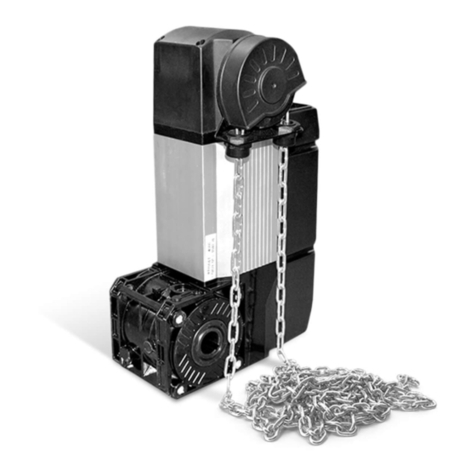
Motorline professional
Motorline professional KVM205 User& installer's manual
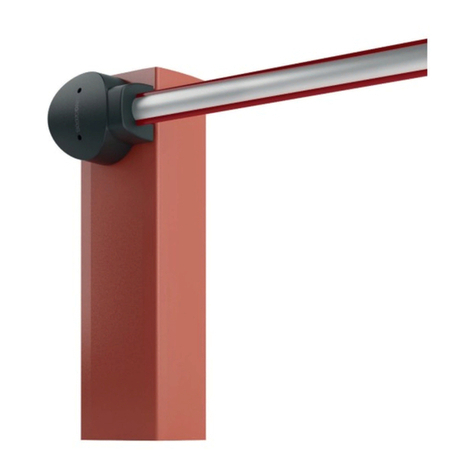
King gates
King gates STAR OPEN Installation and use instructions and warnings
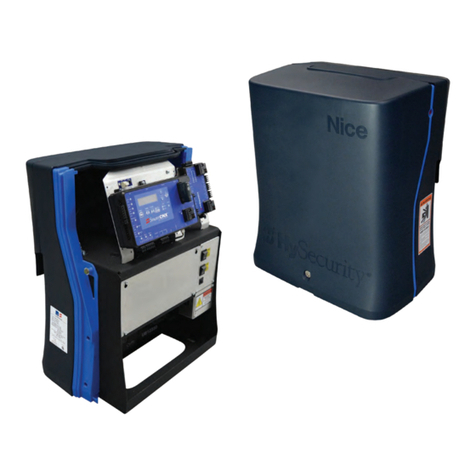
Nice
Nice SlideSmart CNX 15 Installation and programming manual
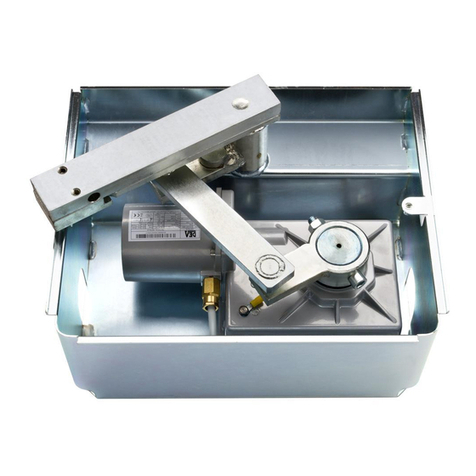
Dea
Dea ghost 200 operating instructions

Nice
Nice hyke HK7024 Instructions and warnings for installation and use
